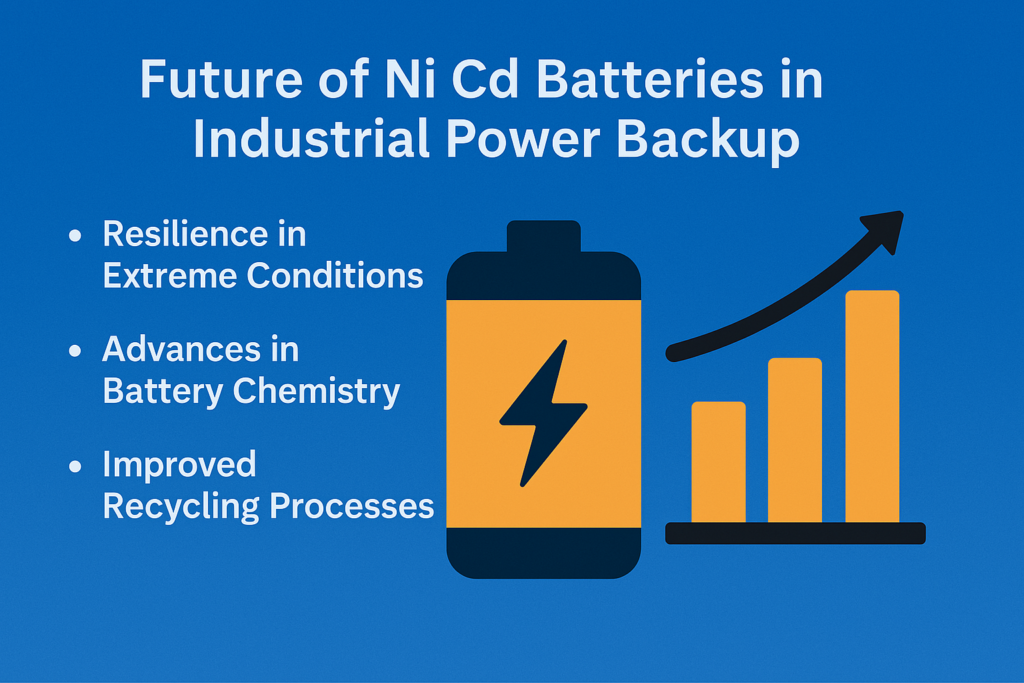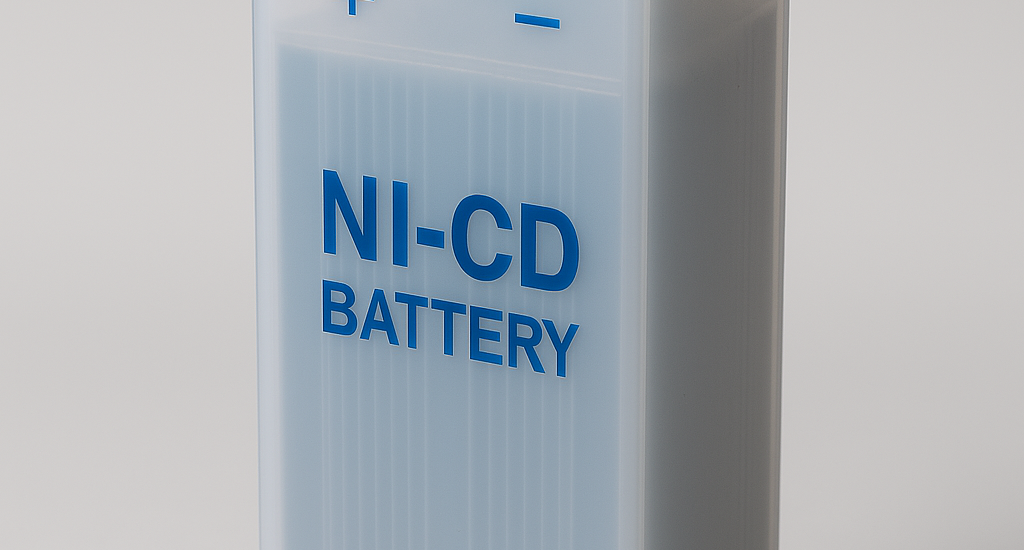In industrial environments, ensuring a reliable and continuous power supply is essential to maintain smooth operations, avoid financial losses, and ensure safety. Power outages or fluctuations can cause severe disruptions, leading to downtime, equipment malfunctions, and even safety hazards. To mitigate these risks, industries turn to robust power backup solutions, with Nickel-Cadmium (Ni Cd) batteries standing out as a preferred choice.
Ni Cd batteries have been a cornerstone of industrial power backup systems for decades. Their reputation for durability, long operational life, and ability to perform efficiently under extreme conditions makes them an invaluable asset. These batteries excel in applications requiring resilience, such as power plants, railway systems, and aviation, where any failure can result in serious consequences. Their ability to withstand deep discharges, operate in harsh environments, and deliver stable power over extended periods ensures they remain a reliable choice despite the emergence of newer battery technologies.
This blog will delve into the advantages, applications, and future of Ni Cd batteries in industrial settings, providing insights into why they continue to be a trusted solution for backup power needs.
Key Takeaways
1. Ni-Cd batteries offer high reliability and long lifespan for industrial backup power systems.
2. Their resistance to extreme temperatures and deep discharge cycles makes them ideal for critical applications.
3. Industries such as power generation, transportation, and oil & gas depend on Nickel-Cadmium batteries for uninterrupted operations.
4. Unlike lead-acid batteries, Ni-Cd batteries require minimal maintenance and have a low self-discharge rate.
5. With ongoing innovations, Ni-Cd batteries remain a viable choice despite competition from newer technologies.
Table of Contents
1. Introduction to Ni Cd Batteries
Nickel-Cadmium (Ni Cd) batteries are a type of rechargeable battery that has been a critical component in many industrial applications for decades. These batteries are known for their reliability, durability, and ability to operate in harsh conditions, making them an ideal choice for critical power backup systems in industries that require uninterrupted operation.
The fundamental structure of a Ni Cd battery involves two main electrodes: nickel oxide hydroxide (NiOOH) for the positive electrode and cadmium (Cd) for the negative electrode. The electrolyte, typically potassium hydroxide (KOH), enables the flow of ions between the two electrodes during the charging and discharging process.
Ni Cd batteries are widely recognized for their long cycle life, meaning they can be charged and discharged thousands of times without significant degradation. This characteristic is particularly important in industries where backup power systems need to perform reliably over long periods without frequent replacement.
The resilience to extreme temperatures is another crucial feature of Ni Cd batteries. They can operate efficiently in temperatures ranging from -40°C to 50°C, which makes them suitable for environments subject to temperature fluctuations, such as power plants, offshore drilling rigs, and transportation systems.
One of the main reasons Ni Cd batteries have remained a preferred choice for industrial applications is their deep discharge tolerance. Unlike some other battery technologies, Ni Cd batteries can endure multiple deep-discharge cycles without compromising their performance. This makes them perfect for use in industries that require long periods of operation under challenging conditions.
Despite their many advantages, Ni Cd batteries have come under scrutiny due to the presence of cadmium, a heavy metal that can be harmful to the environment if not disposed of properly. However, with advances in recycling technology and regulations in place to manage the disposal of cadmium, this concern has been largely mitigated, allowing Ni Cd batteries to remain a safe and effective solution for industrial power backup systems.
As the demand for more sustainable and efficient energy storage solutions grows, Ni Cd batteries continue to play a crucial role in ensuring uninterrupted power for industries where reliability and longevity are paramount. Their ability to maintain stable performance in extreme conditions and over extended periods makes them an irreplaceable asset in modern industrial power backup systems.
2. How Ni Cd Batteries Work
Ni Cd batteries operate through an electrochemical reaction between the nickel oxide hydroxide (NiOOH) cathode and cadmium (Cd) anode. The electrolyte used is potassium hydroxide (KOH), which facilitates ion transfer and maintains conductivity. During charging, the cadmium anode absorbs electrons and converts to cadmium hydroxide, while the nickel hydroxide cathode releases electrons and becomes nickel oxyhydroxide. This process reverses during discharge, allowing the battery to supply power efficiently.
Key Working Mechanisms:
1. Energy Storage and Release: Ni Cd batteries store energy in chemical form and release it as electrical energy when needed, making them highly efficient for backup power applications.
2. Deep Discharge Tolerance: Unlike many other battery types, Ni Cd batteries can endure multiple deep discharge cycles without losing efficiency, ensuring a long operational lifespan.
3. Overcharge Resistance: Their design allows them to tolerate overcharging better than other battery technologies, reducing the risk of damage and prolonging their lifespan.
4. Stable Voltage Output: These batteries provide a steady voltage throughout their discharge cycle, making them ideal for critical industrial applications where consistent power is essential.
3. Advantages of Ni Cd Batteries in Industrial Applications
1. Long Service Life: Ni Cd batteries can last up to 20 years with proper maintenance, significantly outlasting lead-acid and lithium-ion alternatives. Their ability to sustain performance over thousands of cycles makes them an economical long-term investment for industries.
2. High Reliability: They maintain excellent performance even in extreme temperatures ranging from -40°C to 50°C, making them suitable for harsh industrial environments where fluctuations in temperature can severely impact other battery types.
3. Deep Discharge Tolerance: Unlike lead-acid batteries, Ni Cd batteries can endure multiple deep-discharge cycles without losing efficiency, ensuring reliable backup power. This resilience is crucial for industries requiring an uninterrupted power supply.
4. Low Maintenance: With minimal water refilling and servicing requirements, these batteries reduce operational downtime and maintenance costs. Their robust design minimizes the risk of sudden failures.
5. Stable Voltage Output: They provide consistent power delivery, which is crucial for industrial control systems, data centers, and emergency applications. Stable voltage output ensures sensitive equipment operates efficiently without the risk of power fluctuations.
6. Resistance to Electrical Abuse: Ni Cd batteries withstand overcharging and deep discharges better than other battery types, ensuring extended operational efficiency. They are less prone to thermal runaway, a significant concern with certain battery chemistries.
4. Common Industrial Uses of Ni Cd Batteries
1. Power Plants: Used in substations and control systems to ensure uninterrupted power supply during outages, preventing disruptions to energy distribution networks.
2. Railway Systems: Essential for signaling, lighting, and emergency braking power, ensuring passenger safety and operational efficiency. Reliable power backup is critical for railway networks to maintain efficiency and prevent system failures.
3. Aviation: Provides reliable backup power for aircraft electrical systems, ensuring operational security in case of system failures. Ni Cd batteries are widely used in aviation due to their ability to function under extreme conditions.
4. Oil & Gas Industry: Utilized in offshore drilling rigs and refineries to power safety and monitoring systems, ensuring smooth operations even in remote locations where power failures can be dangerous.
5. UPS Systems: Used in industrial and data center UPS systems, ensuring seamless power transitions and preventing downtime that could lead to substantial financial losses.
5. Ni Cd Batteries vs. Other Battery Technologies
| Feature | Ni Cd batteries | Lead-Acid Batteries | Lithium-Ion Batteries |
|---|---|---|---|
| Lifespan | 15-20 years | 3-7 years | 8-15 years |
| Maintenance | Low | High | Low |
| Temperature Tolerance | -40°C to 50°C | 0°C to 40°C | -20°C to 60°C |
| Deep Discharge Performance | Excellent | Poor | Moderate |
| Environmental Impact | Contains Cadmium | Acid Spillage Risk | Less Toxic |
6. Maintenance and Lifecycle Considerations
To maximize efficiency and longevity, Ni Cd batteries require regular inspections, proper charging cycles, and avoiding over-discharge. Unlike lead-acid batteries, they do not require frequent water refilling, reducing overall maintenance efforts and costs. Their durability and reliability make them ideal for critical applications where battery failure is not an option.
7. Environmental Impact and Recycling
Although Ni Cd batteries contain cadmium, a hazardous heavy metal, recycling programs ensure safe disposal and material recovery. Many countries have strict regulations to minimize environmental risks and promote sustainable battery disposal practices. Proper disposal and recycling help mitigate the environmental risks associated with cadmium while allowing the recovery of valuable materials.
8. Future of Ni Cd Batteries in Industrial Power Backup

Despite increasing competition from lithium-ion and other advanced battery technologies, Ni Cd batteries remain a viable choice due to their resilience in extreme conditions, low maintenance requirements, and extended lifecycle. Ongoing advancements in battery chemistry and recycling processes will likely enhance their sustainability and efficiency, ensuring their continued relevance in industrial applications.
Final Thoughts
Ni Cd batteries continue to play a critical role in industrial power backup systems due to their reliability, long lifespan, and ability to function under demanding conditions. While alternative battery technologies are emerging, the unique advantages of Nickel Cadmium batteries make them an irreplaceable component in many industrial applications.
Looking for Reliable Ni Cd Batteries for Industrial Power Backup?
Ensure uninterrupted operations with high-performance ni cd batteries from Digital Electric. Our long-lasting, low-maintenance, and high-efficiency batteries are designed to withstand extreme conditions and provide consistent power backup for critical industrial applications.
20+ years lifespan
Deep discharge tolerance
Reliable performance in extreme temperatures
Minimal maintenance requirements
Power up your industry with Digital Electric’s trusted Ni Cd batteries solutions. Contact us today to find the perfect backup power solution for your needs!
FAQs
Why are Ni-Cd batteries preferred for industrial power backup?
Ni-Cd batteries offer a long lifespan, resistance to extreme temperatures, and reliable power backup, making them ideal for industrial use.
How long do Ni-Cd batteries last?
With proper maintenance, Ni-Cd batteries can last up to 20 years, significantly longer than lead-acid or lithium-ion alternatives.
Are Ni-Cd batteries environmentally friendly?
While they contain cadmium, a hazardous material, proper recycling programs ensure minimal environmental impact.
How do Ni-Cd batteries compare to lithium-ion batteries?
Ni-Cd batteries offer better performance in extreme temperatures and deep discharge tolerance but are heavier than lithium-ion batteries.
Where are Ni-Cd batteries commonly used?
They are widely used in power plants, railways, aviation, oil & gas, and UPS systems for backup power applications.
Why should I choose Ni Cd batteries over lead-acid batteries?
Ni Cd batteries have a longer lifespan, better temperature tolerance, and require less maintenance compared to lead-acid batteries.
Are Ni Cd batteries cost-effective?
Yes, despite a higher initial investment, their long service life and low maintenance costs make them a cost-effective solution.
Can Ni Cd batteries withstand harsh industrial conditions?
Absolutely! Ni Cd batteries perform exceptionally well in extreme temperatures and demanding environments, making them ideal for industrial applications.
How do Ni Cd batteries ensure reliability in power backup?
Their deep discharge tolerance, stable voltage output, and resistance to overcharging make them highly reliable for backup power systems.

